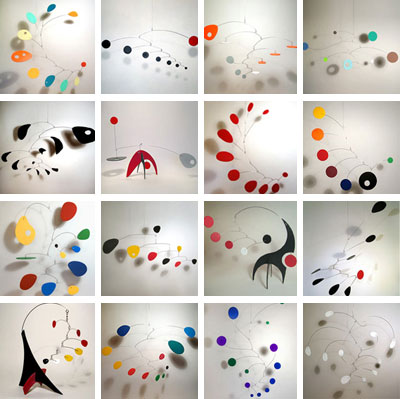The sculptor Alexander Calder is well known for his mobiles. Calder invented the mobile in 1931. Marcel Duchamp suggested the name "mobile".[1] Mobiles are also popular in the nursery, where they hang over cribs to give infants something to entertain them and give them external visual stimulation.
The meaning of the term “mobile” as applied to sculpture has evolved since it was first suggested by Marcel Duchamp in 1931 to describe the early, mechanized creations of Alexander Calder. At this point, “mobile” was synonymous with the term “kinetic art”, describing sculptural works in which motion is a defining property. While motor or crank-driven moving sculptures may have initially prompted it, the word “mobile” later came to refer more specifically to Calder’s free-moving creations. Influenced by the abstract work of Piet Mondrian, Joan Miró and Sophie Taeuber-Arp, Calder in many respects invented an art form where objects (typically brightly coloured, abstract shapes fashioned from sheet metal) are connected by wire much like a balance scale. By the sequential attachment of additional objects, the final creation consists of many balanced parts joined by lengths of wire whose individual elements are capable of moving independently or as a whole when prompted by air movement or direct contact. Thus, “mobile” has become a more well-defined term referring to the many such hanging constructs Calder produced in a prolific manner between the 1930s and his death in 1976. A succinct definition of the term “mobile” in a visual art sense could be a type of kinetic sculpture in which an ensemble of balanced parts capable of motion are hung freely in space.Wikipedia: Mobile (sculpture)
A mobile is a type of kinetic sculpture constructed to take advantage of the principle of equilibrium. It consists of a number of rods, from which weighted objects or further rods hang. The objects hanging from the rods balance each other, so that the rods remain more or less horizontal. Each rod hangs from only one string, which gives it freedom to rotate about the string.
What is an art mobile?

Frithmobiles: Mobiles by Julie Frith
Mobile (art), in art, type of sculpture characterized by the ability to move when propelled by air currents, by touch, or by a small motor at any one time. The most striking feature of the mobile is that, unlike traditional sculpture, it achieves its artistic effect through movement; it is the most familiar form of kinetic art, which requires movement of some kind. A typical mobile consists of a group of shapes, frequently abstract, that are connected by wires, string, metal rods, or the like. Although mobiles are usually suspended, some are designed to stand on a platform or floor. The first experimental mobiles were the work of the French artist Marcel Duchamp in the 1920s.The form, however, was developed to its finest expression so far by the American sculptor Alexander Calder, beginning in the 1930s. written by Marco Mahler
Subscribe to:
Posts (Atom)
